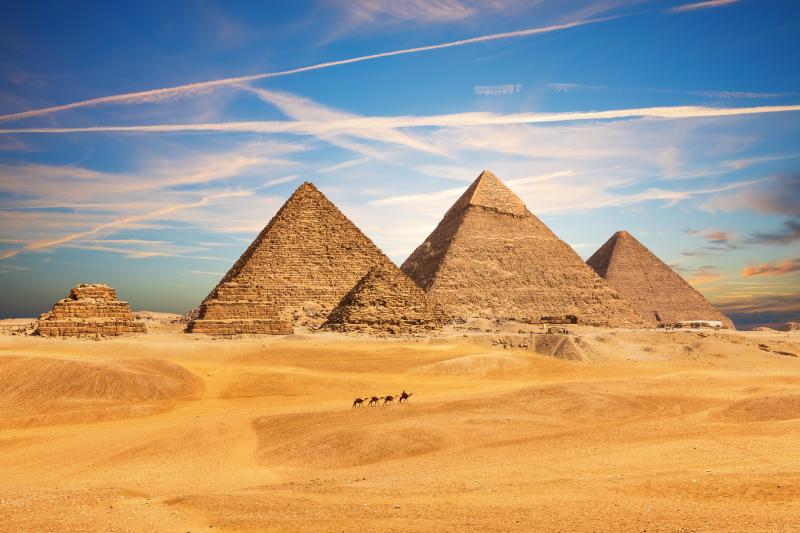
The Pyramids of Giza have stood on the Giza Plateau for over 4,500 years as awe-inspiring symbols of ancient Egyptian engineering. Built during the 4th dynasty, these royal tombs including the Great Pyramid of Khufu showcase incredible craftsmanship, with Khufu’s pyramid originally rising 481 feet and constructed from about 2.3 million stone blocks weighing up to 15 tons each.
The Giza complex extends far beyond the Great Pyramid, featuring Khafre’s 471-foot-tall pyramid and Menkaure’s 218-foot structure. Surrounding these iconic tombs are mortuary temples, solar boat pits, and the majestic Great Sphinx measuring 240 feet long and 66 feet high. Recent technological scans have revealed hidden voids inside the Great Pyramid, adding to the enduring mystery. This remarkable site not only showcases ancient engineering but also offers deep insight into Egypt’s royal legacy and religious beliefs.
The Pyramids of Giza are located just on the outskirts of Cairo, Egypt’s bustling capital city. Situated on the Giza Plateau, the pyramids are about 18 kilometers (11 miles) southwest of Cairo's city center. The site is easily accessible by car, taxi, or even public transportation from Cairo, making it an unmissable destination for those exploring the region.

The pyramids of Giza stand as eternal monuments to three formidable pharaohs from Egypt's 4th dynasty who reigned between 2575–2465 BCE. Each magnificent structure bears distinct characteristics reflecting the royal vision and ambition of its creator.
Pharaoh Khufu (also known as Cheops) ordered the construction of the first and largest pyramid at Giza around 2550 BCE. The second ruler of the 4th dynasty, Khufu's enormous tomb ascends to an impressive original height of 481.4 feet (147 meters). This massive structure demanded approximately 2.3 million stone blocks, each weighing an average of 2.5 tons. Within its depths lie three chambers, including the King's Chamber constructed entirely of granite. Curiously, the chambers contain no inscriptions or decorations, as these elements emerged in royal tombs more than 200 years later. Seven boat pits surround Khufu's pyramid, one of which yielded a remarkably preserved 142-foot (43-meter) cedar vessel.

Khafre (Chephren), Khufu's son, erected the second pyramid at Giza approximately 2520-2494 BCE. Though marginally smaller than his father's monument, Khafre strategically positioned his pyramid 10 meters (33 feet) higher on the plateau, creating a visual illusion of greater size. His structure features distinctive casing materials,the lower levels showcasing red granite while limestone adorns the upper portions. The Great Sphinx, perhaps the most iconic feature associated with Khafre, emerges from the limestone bedrock of the Giza plateau. This majestic creature, displaying a lion's body and a pharaoh's head, extends 240 feet in length and rises 66 feet high. Archaeological evidence strongly links Khafre as the sphinx's creator.

Menkaure (Mykerinus), son of Khafre, completed the pyramidal trio around 2490 BCE. His pyramid, reaching just 215 feet (65 meters) in height, represents the smallest of the three monuments. Despite its more modest dimensions, Menkaure's pyramid boasts more intricate internal chambers than Khafre's, featuring unique niched panels and six large recesses. This structure yielded some of Egyptian history's most exquisite sculptures, including remarkable triads depicting the king embraced by various deities. Unlike its companions, Menkaure's pyramid retains none of its original polished limestone casing.

The pyramids were primarily constructed from limestone, with fine white limestone used for the outer casing and granite from Aswan reserved for chambers and structural features. Basalt was laid for flooring. Workers employed copper tools chisels, saws, and hammers often made from arsenical copper alloys for added strength. Bronze tools also emerged as early as the Second Dynasty. Standard limestone blocks measured about one cubic meter and weighed around 2.6 tons.
Contrary to popular belief, the Great Pyramid was not built by slaves but by a workforce of about 4,000 core laborers supported by 16,000:20,000 auxiliary workers. These skilled artisans were highly organized into crews, gangs, phyles, and smaller teams, each with names like "Friends of Menkaure." Workers were compensated with food rations typically ten loaves of bread and beer daily.
The Nile was vital for transporting materials. A now extinct tributary, Ahramat, once connected 31 pyramid sites. Papyri from Wadi al-Jarf reveal workers shipped limestone by boat from Tura to Giza, proving how Egyptians merged land and river logistics in pyramid construction.

Beneath their massive stone exteriors, the pyramids house intricately designed chambers intended as eternal tombs for pharaohs. Though modest in decoration, these interiors reveal deep insights into ancient Egyptian beliefs and showcase extraordinary architectural precision.
The King's Chamber, located near the Great Pyramid's center, is built from massive polished granite blocks and topped with five relieving chambers to support its weight. It contains a 3.75-ton red granite sarcophagus. Below, the so-called Queen's Chamber never actually used for a queen features fine limestone walls, a gabled ceiling, and a niche likely meant for a statue or the king’s ka (soul).
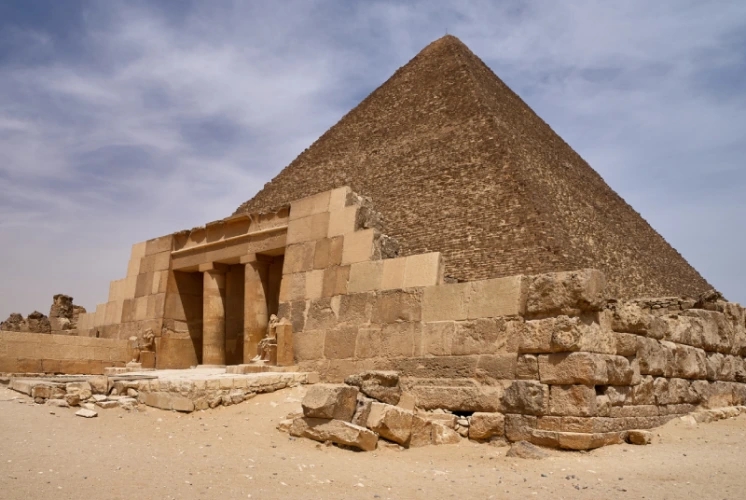
Reaching these sacred chambers demands navigation through confined passageways. Visitors must traverse an ascending passage, pass the Queen's Chamber, and proceed through the magnificent Grand Gallery to access the King's Chamber. Both chambers possess "air shafts" that extend outward through the pyramid walls. Robotic exploration in 1993 revealed a limestone door with copper handles at the end of the southern shaft in the Queen's Chamber. Further investigation in 2002 uncovered a second door positioned just 21 centimeters behind the first.
While Khufu's granite sarcophagus remains within the King's Chamber, his mummy and funerary treasures vanished millennia ago. Waynman Dixon's 1872 exploration yielded three curious artifacts from the Queen's Chamber shafts: a bronze hook, a granite ball, and a cedar-wood piece. Though initially categorized as workers' tools, scholars now suspect these "Dixon Relics" served specific ritual purposes.
Modern technology continuously unveils pyramid secrets hidden for millennia. Cosmic-ray imaging in 2023 identified a previously unknown 30-foot corridor situated above the Great Pyramid's entrance. Robotic exploration has revealed hieroglyphic markings potentially representing workers' graffiti. Italian researchers recently employed Synthetic Aperture Radar technology to detect possible structures beneath the enigmatic Tomb of Osiris.

The Giza pyramids function not as isolated monuments but as centerpieces within elaborate ceremonial precincts. These expansive complexes house temples, tombs, and ritual structures that played crucial roles in ancient Egyptian funeral customs and afterlife beliefs, making them a highlight of many Egypt Tours.
Each Giza pyramid complex includes two temple types: valley temples near the floodplain and mortuary temples beside the pyramid. Khafre’s valley temple, the best preserved, features a T-shaped hall with 16 granite pillars, alabaster flooring, and once held 23 royal statues. These temples hosted key rituals, including mummification and offerings, with Khafre’s mortuary temple setting the blueprint for future temple layouts.

Surrounding the pyramids are cemeteries filled with mastabas flat-roofed tombs used by officials seeking closeness to the pharaoh in death. Excavations near Khufu’s pyramid also revealed workers’ tombs, proving that paid laborers, not slaves, built the pyramids. These workers were buried with honors and provisions, with tomb size and placement reflecting their social rank.
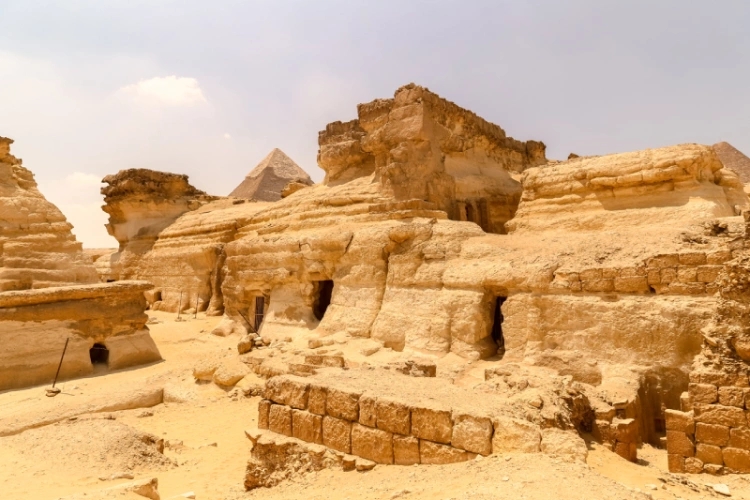
The iconic Great Sphinx, carved from a single limestone outcrop, measures an impressive 240 feet (73 meters) long and 66 feet (20 meters) high. Most scholars attribute this colossal sculpture to Khafre, whose facial features it appears to bear. The creation of this monument demanded significant labor; approximately 100 workers wielding stone hammers and copper chisels would have required roughly three years to complete the carving. Originally painted in vibrant colors and adorned with a ceremonial beard, the Sphinx has endured substantial erosion and damage over thousands of years.

Solar boat pits around Khufu’s pyramid reflect beliefs in the pharaoh’s journey to the afterlife. A 142-foot cedar boat, discovered in 1954, was found dismantled into 1,224 pieces and later reconstructed. Causeways, like Khafre’s 494.6-meter path, connected valley and mortuary temples many aligning with the now-extinct Ahramat tributary supporting both funerary processions and offerings via land and water routes.
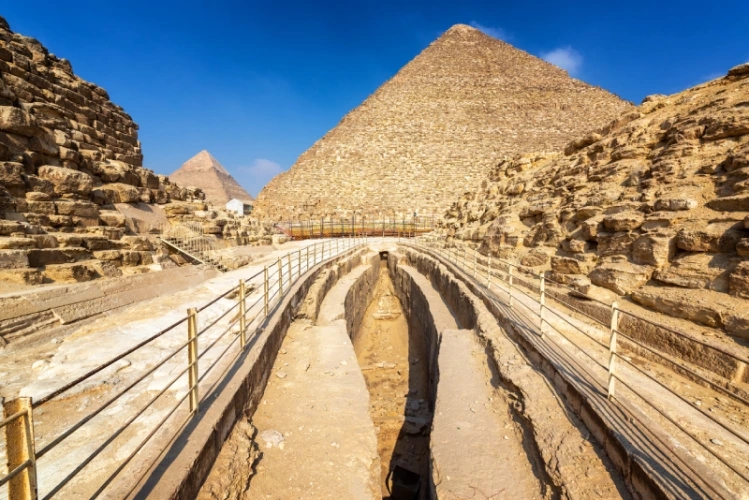
For those wanting to stay close to the Pyramids of Giza, there are a variety of accommodations to suit every budget:
Luxury: The Mena House Hotel offers stunning views of the pyramids and an upscale experience. This historic hotel has hosted many famous guests over the years.
Mid-Range: The Pyramids View Inn is a great choice for a comfortable stay with impressive views of the pyramids at a reasonable price.
Budget: For a more affordable option, Giza Guest House offers basic amenities and proximity to the pyramids without breaking the bank.
The area around the pyramids also has numerous small guesthouses and hotels offering a range of amenities, making it easy to find a place to stay no matter your budget.
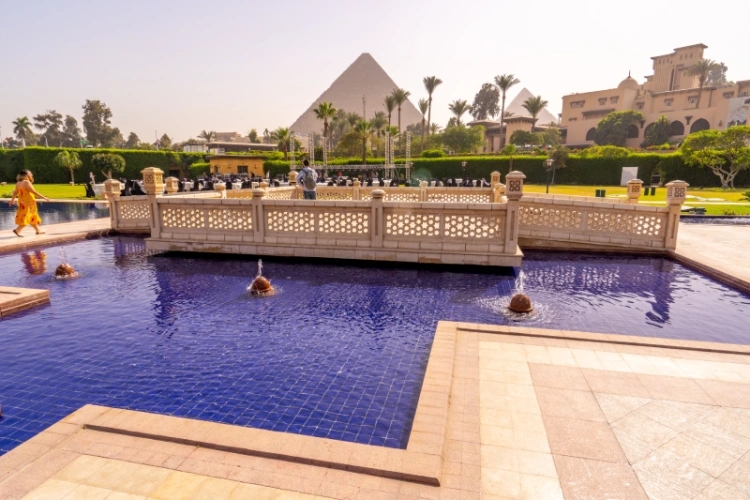
The Pyramids of Giza can be visited year-round, but certain times of the year are more comfortable for tourists:
Best Time: The most ideal months to visit are from October to April, when the weather is cooler, making it more comfortable to explore the pyramids and surrounding areas. Daytime temperatures during this period are pleasant, averaging between 20-25°C (68-77°F).
Avoid Summer: The summer months (June to August) can be scorching, with temperatures often exceeding 40°C (104°F). It can be difficult to explore the pyramids comfortably in the intense heat.
Morning Visits: For fewer crowds and cooler temperatures, try to arrive early in the morning. The pyramids are less crowded, and you'll also enjoy the soft morning light.
The Giza pyramids stand as enduring symbols of ancient Egyptian genius, built by 4th dynasty pharaohs Khufu, Khafre, and Menkaure. Far more than tombs, they reflect royal power, religious belief, and architectural excellence. Recent discoveries debunk slave-labor myths, highlighting instead the role of skilled laborers and advanced construction techniques, including water transport via the Ahramat tributary and sophisticated ramp systems. Inside, the chambers display remarkable precision and hidden secrets still being uncovered. Surrounded by temples, tombs, and ceremonial causeways, the pyramids remain awe-inspiring spiritual complexes and timeless testaments to ancient Egypt's pursuit of immortality.
Q1. How tall is the Great Pyramid of Giza and how long did it take to build?
The Great Pyramid of Giza originally stood at 481.4 feet (147 meters) tall. It took approximately 20 years to complete its construction, which began around 2550 BCE during the reign of Pharaoh Khufu.
Q2. Are visitors allowed to enter the pyramids at Giza?
Yes, visitors can enter the interiors of all three pyramids at Giza. However, each pyramid requires a separate ticket for entry. It's important to note that the spaces inside can be cramped and hot, so it's not recommended for those with claustrophobia or mobility issues.
Q3. What should I wear when visiting the Pyramids of Giza?
When visiting the pyramids, it's best to wear comfortable, lightweight clothing that covers your shoulders and knees out of respect for local customs. Closed-toe, comfortable shoes are essential due to the uneven terrain. Don't forget a hat and sunscreen for protection against the sun.
Q4. Were the pyramids built by slaves?
No, contrary to popular belief, the pyramids were not built by slaves. Archeological evidence shows they were constructed by skilled, paid laborers. These workers were organized into teams and received food rations as payment for their work.
Q5. What's inside the Great Pyramid of Giza?
The Great Pyramid contains several chambers and passageways. The main chambers are the King's Chamber, which houses a granite sarcophagus, and the misnamed Queen's Chamber. There's also the Grand Gallery, a tall corbelled passageway, and several smaller chambers and shafts. Recent technological explorations have revealed hidden corridors and voids within the pyramid structure.
Q6. Is it easy to find different types of accommodations around the pyramids?
Absolutely. The area features a range of guesthouses and hotels to suit every budget and travel style.
Q7. When is the best time to visit the Pyramids of Giza?
The best time to visit is from October to April, when the weather is cooler and more comfortable for outdoor sightseeing.


© Copyright 2025 Get Egypt Tour. All rights reserved.